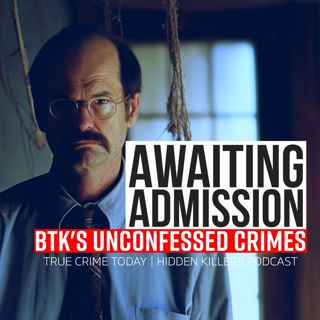
Is New BTK Investigation Giving False Hope to Victim Families?
Jaksokuvaus
In a stunning revelation on the popular podcast "Hidden Killers," Tony Brueski revealed that the chilling figure of BTK - Dennis Rader - might have had more victims than previously known. Brueski's intense conversation with Bob Motta, Defense Attorney and host of the podcast Defense Diaries, left listeners grappling with a myriad of new details and insights into the ongoing investigation. "Dennis Rader, BTK being looked at again... Four cases is what he is saying that he believes could very likely be linked to Dennis Rader," Brueski stated. One such case is that of Cynthia Dawn Kinney, who went missing in 1976. The only piece of evidence linking her disappearance to Rader was an obscure reference about a "bad wash day" he made, alluding to his time installing ADT alarm systems across the street from where Kinney lived. "We do see some evidence that Rader was in the area at the time," says Brueski. However, what is striking about the renewed interest in these cases is not just the implication that there might be more victims, but the level of sophistication and tenacity that investigators are employing to unearth evidence. Motta highlighted how advances in DNA technology could be instrumental in these cases. "The advantages, the leaps and bounds that DNA technology has taken... the hope is going to be that they're going to be able to do direct comparisons." Furthermore, a national task force has been assembled to look into these cases, comprising many experts known to Brueski and Motta. Among them is Kerri Rawson, Dennis Rader's own daughter, who has been proactively aiding federal agencies with information. Motta spoke highly of Rawson's resilience: "She's an amazing person... the fact that she survived that trauma and is putting it all to very good use these days is admirable." There's an underlying sense of tragedy as Rawson, in her bid to help victims, faces societal backlash due to her lineage. One pivotal avenue the investigation is taking involves a series of photographs taken by Rader himself. These photos capture Rader wearing his victim's clothing. The aim? To determine if any of the clothing pieces could belong to victims he hasn't been charged for. "One of the bigger things that it seems they're taking a look at are those pictures," said Brueski. The challenge lies in the age of these photos – taken in the 1970s or 1980s – and how they can conclusively link them to potential victims. In response to Brueski's query on whether a mere photo would suffice as evidence, Motta asserted that while it could be powerful, it's not enough on its own. "If you can get a few pieces of extremely powerful circumstantial evidence, it'll probably be enough." Motta drew parallels with the case of John Wayne Gacy, where unique items and medical records were essential in identifying victims from skeletal remains. Both Brueski and Motta's conversation touched upon the overarching importance of building a solid case. But for many, the pressing question isn't just about convicting Rader again. It's about giving families, who've lost their loved ones under mysterious circumstances, a chance at closure. So, as the task force dives deep into old evidence and new technology in hopes of shedding light on these cold cases, we are left with an unsettling thought: What if there are still secrets hidden in the shadows of BTK's grisly past? Want to listen to ALL of our podcasts AD-FREE? Subscribe through APPLE PODCASTS, and try it for three days free: https://tinyurl.com/ycw626tj Follow Our Other Cases: https://www.truecrimetodaypod.com The latest on Catching the Long Island Serial Killer, Awaiting Admission: BTK’s Unconfessed Crimes, Chad & Lori Daybell, The Murder of Ana Walshe, Alex Murdaugh, Bryan Kohberger, Lucy Letby, Kouri Richins, Justice for Harmony Montgomery, The Murder of Stephen Smith, The Murder of Madeline Kingsbury, and much more! Listen at https://www.truecrimetodaypod.com